Sometimes there is a product that I really want to like, yet I am forced to write an unflattering review of it because it fails to perform. This is one of those times.
During my evaluation of the ExtremeBeam M600, I experienced two separate failures that preclude me from recommending this light. Both were related to the impact resistance of the light. I also encountered other issues, though none of them individually would preclude me from recommending the light.
The specs and construction were very promising, but in the end, I was very disappointed.
General Characteristics
The M600 is a handheld flashlight designed for tactical use. It is billed by ExtremeBeam as “…incredibly rugged and virtually indestructible…” Unfortunately, my sample did not appear to be as rugged as the marketing suggested. Skip down to the drop test for additional information.
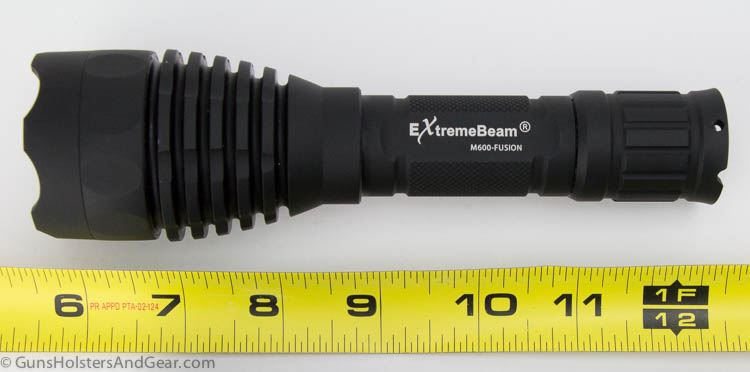
The body and head are machined 6061 aluminum with a black finish.
ExtremeBeam states the flashlight has something called the Anti-Recoil System. This allows the light to be used while mounted on a firearm up to and including a .50 BMG. No additional specifications or information is provided on this.
A single switch located in the tail cap controls the flashlight. It allows for a half-press for momentary-on, while a solid click turns the light on in a constant mode. Multiple half-presses cycle the light through the different output options: high, medium, low and strobe. More information on these is located in the Light Output section below.
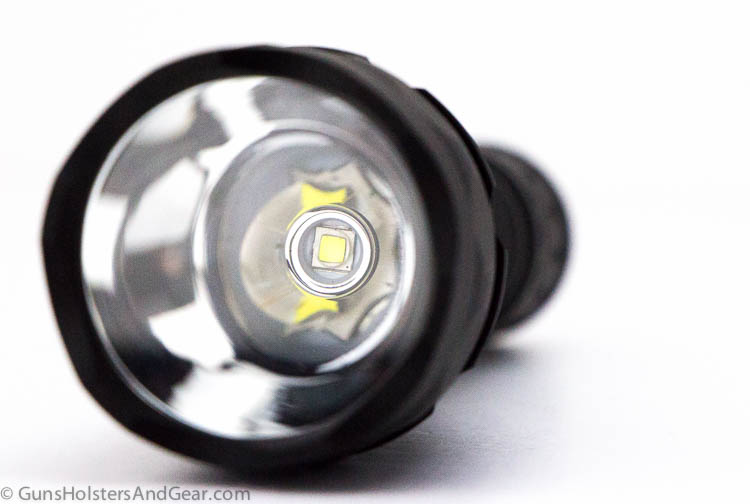
ExtremeBeam uses a machined aluminum reflector instead of plastic or some other material. In theory, this makes the reflector more durable. The company claims the “near-perfect” reflector “generates the tightest beam angle in the industry.”
The head of the M600 can turn. This allows the owner to adjust the beam shape: narrow to wide. If you twist it far enough, you can remove the head entirely leaving a bare LED bulb that can serve as an area light.
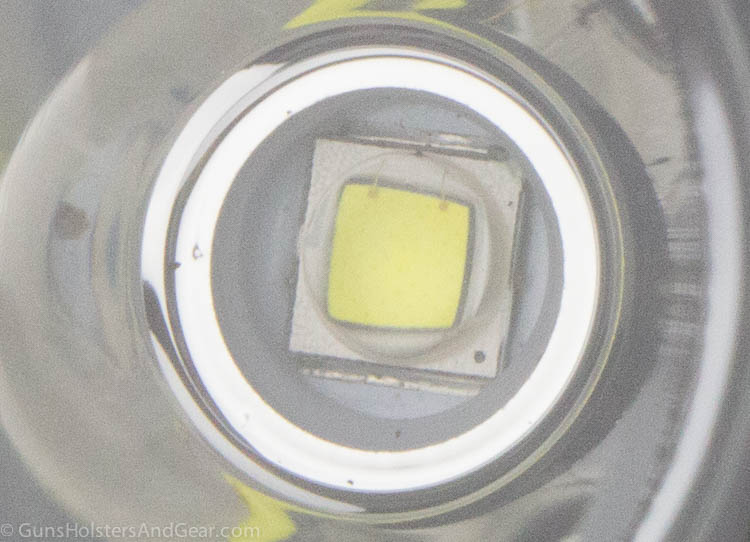
ExtremeBeam advised the company uses CREE LEDs in the M600 flashlights.
Like many of its competitors, the ExtremeBeam flashlights are made in China. Interestingly, the packaging uses “PRC” (People’s Republic of China) instead of the more commonly used name China.
The MSRP of the M600 is $129.95. Batteries are not included with this light.
Specifications
The ExtremeBeam M600 specifications are:
| Total Light Output | 600 lumens |
| Peak Beam Intensity | 25,000 candelas |
| Beam Distance | 330 meters |
| Runtime | 6 hours |
| Battery Power | 2x CR123A |
| Weight | 8.9 oz |
| Length | 6.4″ |
| Impact Resistance | 2.5 meters |
| Water Resistance | IPX8 (30 minutes at 30 feet) |
| MSRP | $129.95 |
Light Output
The M600 has four different light modes: high, medium, low and strobe. The high output level is rated to throw 600 lumens and 25,000 candela. For the lower light levels, lumens drop to 272 and 34. Strobe operates at a full 600 lumens.
Unfortunately, ExtremeBeam was not able to provide numbers for peak beam intensity or beam distance for the lower output levels.
For information on light output over time, jump down to the Power section below. I found the 6 hour runtime on the high output mode to be laughable and my testing would seem to back that up.
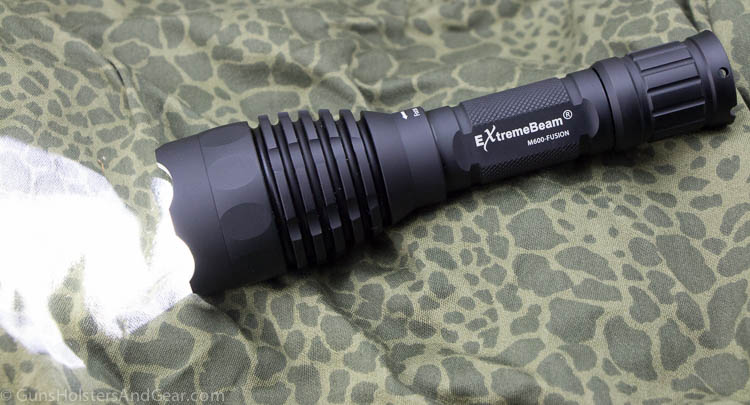
There are two controls on the M600: a tail cap button switch and the rotating head. The tail cap switch turns the light on and picks the output level. The rotating head alters the beam focus. More information on this is in the Beam Focus section below.
Power Sources
As indicated in the specifications above, the M600 runs on a pair of CR123a batteries that are not included. Additionally, the flashlight will operate on two sources of rechargeable energy: a pair of rechargeable CR123a batteries (aka RCR123) or a single 18650 battery stick.
Rechargeable CR123a and 18650 batteries are thicker than standard CR123a batteries and will not fit in every flashlight body. However, the M600 has a slightly oversized interior diameter to accommodate them.
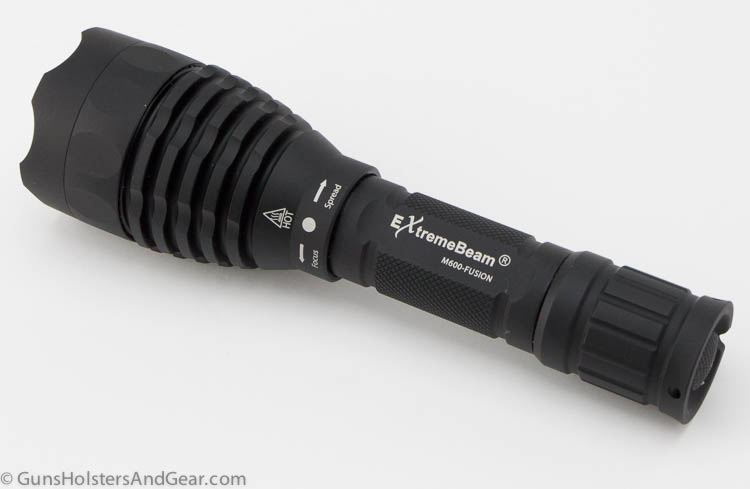
Rechargeable batteries do have drawbacks, but they can pay for themselves many times over when compared to the operating costs of buying disposable CR123 units.
Tail Cap Switch
The tail cap has a rubber-covered switch on the butt end. The rubber covering has a rough texture allowing the thumb to find it quickly without looking.
A half-press of this switch will momentarily activate the light. A full press and click will put it into constant-on mode. This is pretty much like a lot of other flashlights on the market.
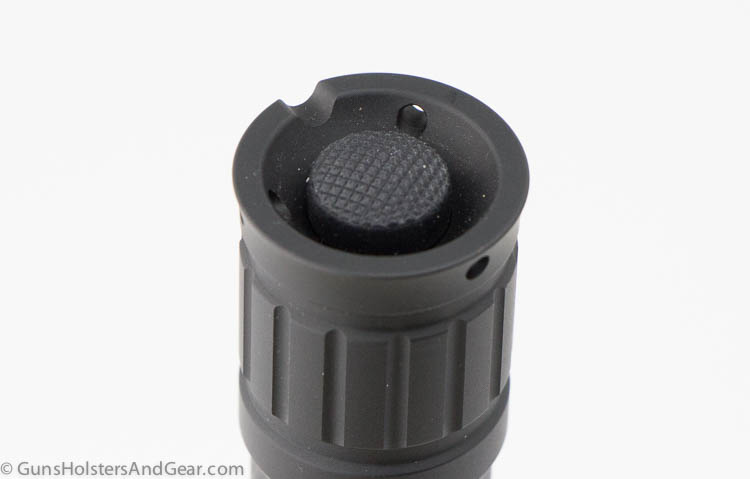
Since the light has multiple output modes, the switch also controls these. With each half-press, the light cycles through the modes. This is where I have a real problem with the light.
If I am clearing a room or house, I may flash an area momentarily, move and then flash again. Each time I do this, the light advances through the cycle. This means that from activation to activation, I will not have consistency in light output. This is a major problem from my perspective.
For a light to be useful in a tactical application, I should have some way to select the mode I want to use and then keep it on that mode for the duration of the event. For example, the Streamlight TEN-TAP equipped flashlights allow the user to lock out all modes except high, or to quickly pick modes depending on a double or triple tap of the switch. Check out my ProTac HL review for additional details on this.
If ExtremeBeam is going to market itself as a manufacturer of tactical lights, I would really like to see them offer lights with either one mode or incorporate some better method of selecting the mode when the light is being used.
Beam Focus
The rotating head allows the user to change the beam from a narrow focus to a wider one. My experience with changeable focus has been mixed in the past, with most lights offering an imprecisely focused narrow beam with dark spots in the pattern at all beam widths. My experience with the M600 did not improve my perception of variable beam focus flashlights.
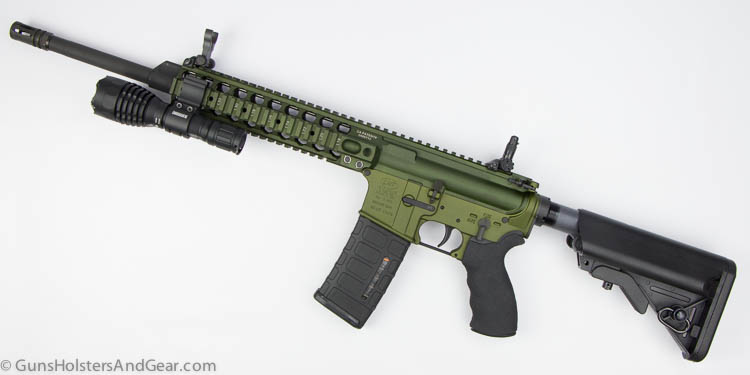
I did not see any shadows or dark spots in the M600 beam with a narrow beam. With a wide beam, however, a cross or “X” shaped pattern appeared in the center of the beam. Initially, the X is not visible, but as you de-focus the beam more and more, it becomes larger and larger.
Additionally, there were rings of light evident in the beam. The rings looked similar to ripples on a still pond if you drop a pebble into it. I did not find that the rings inhibited performance, but I did find them a little distracting. Presumably, the rings are a result of the machining process in the reflector production.
One of the things I encountered that I absolutely did not like was that focusing the head sometimes altered the power output of the light. For example, if I turned on the light on the high power setting with the narrow-most beam, the light would shift to the next lower power setting when I defocused the beam.
Changing the power output levels was not consistent when focusing the beam. Sometimes the flashlight would maintain a high output, other times it would go to a lower setting or even strobe. An inconsistent problem is tough to diagnose, and I was never able to reliably recreate the problem.
General Construction
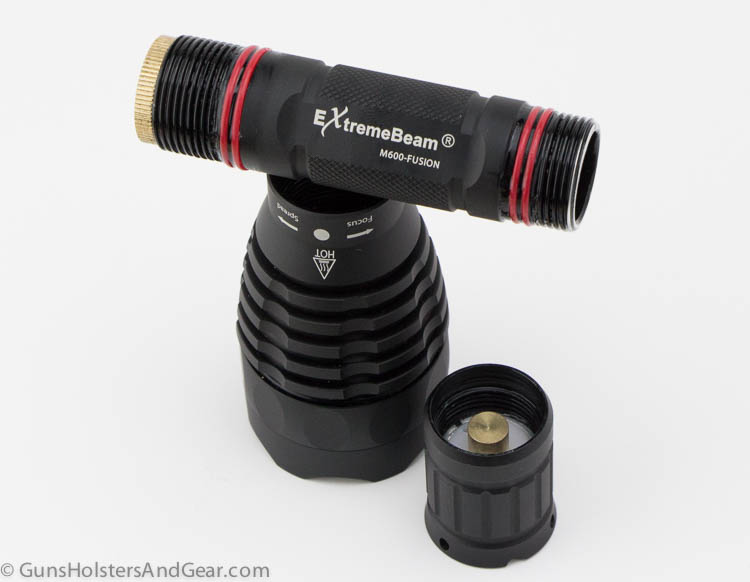
As I previously mentioned, both the body and the reflector are machined aluminum. The M600 flashlight uses square cut threads and has double-O rings on both ends of the body to prevent water intrusion.
The light feels solidly built, and as stated above, it is supposed to be able to handle both 2.5 meter drops and the recoil of a .50 BMG. However, if you skip down to the Drop Test section, you will see that the M600 failed the drop test…twice.
Testing
Over a period of time, I have developed a testing protocol for flashlights. I test for:
- light output over time
- surface heat
- impact resistance
- water resistance
My tests are not done to the FL 1 standard. The ANSI/NEMA FL 1 standard is a voluntary set of tests and reporting methods developed for flashlight manufacturers. The idea is to provide customers with information that can be used to compare the characteristics of different lights.
While the standards are not perfect, they are a step forward for consumers. However, aspects of the standard can be gamed, and some aspects are not terribly useful. So, I’ve created my own set of tests to help readers understand what each light can, and cannot, do. Check out my flashlight review page for additional information.
FL 1 Standard: Not Used
I cannot find any claims by ExtremeBeam that they adhere to the FL 1 standard. However, the packaging used by ExtremeBeam uses symbols that are very similar to the icons used in the FL 1 standard. The packaging is so similar that I actually thought the company was adhering to the FL 1 standard, and only later did I discover discrepancies that suggested ExtremeBeam was not using the FL 1 standard.
Here are examples of the FL 1 standard icons compared to the packaging from the ExtremeBeam M600:
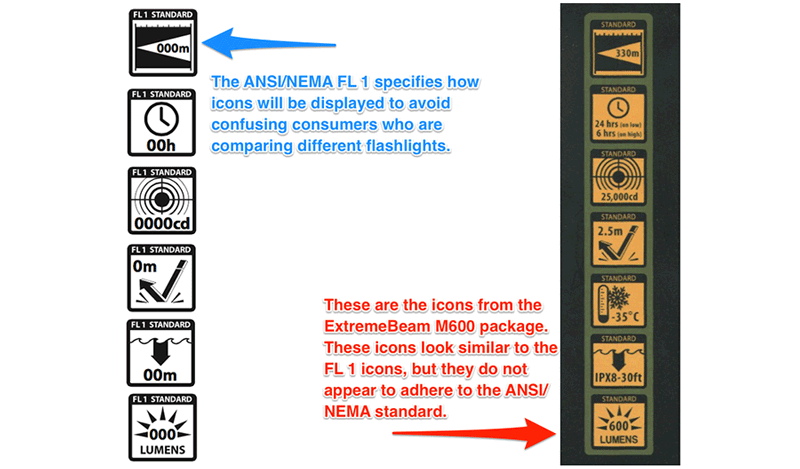
In addition to the icons missing the “FL 1” designation, the impact resistance icon does not adhere to the FL 1 reporting standards. According to sections 2.6.6 and 3.3.5, the impact resistance standard is rounded down to the nearest whole number. So, if ExtremeBeam adheres to the FL 1 standard, the number should be reported as 2 meters, not 2.5.
I should note that when I originally wrote this review in the Spring of 2015, I indicated that the company adhered to the FL 1 standard. I forwarded the company a copy of the original article with a request for any feedback. I did not receive any corrections regarding the FL 1 standard.
Output Over Time
The only way to truly know how much light a flashlight emits is to use an illuminating sphere. A commercial sphere can cost $10,000 or more. I have built my own, which allows me to do measurements of light output over time, and reasonable comparisons of output compared to the other flashlights I have tested. I cannot measure absolute light output.
At the high output level, ExtremeBeam advises a run time of 6 hours on a pair of CR123 batteries. For a 600 lumen flashlight, that is a pretty incredible rating.
According to the information I received from ExtremeBeam, the light will run at maximum output for 40% of the battery life. Since the light is rated at six hours, I would expect that the maximum power level would be maintained for about 2.4 hours. If accurate, that is what I would consider exceptionally good performance.
Unfortunately, the measurements I made in my illuminating sphere were much different than what the packaging suggests.
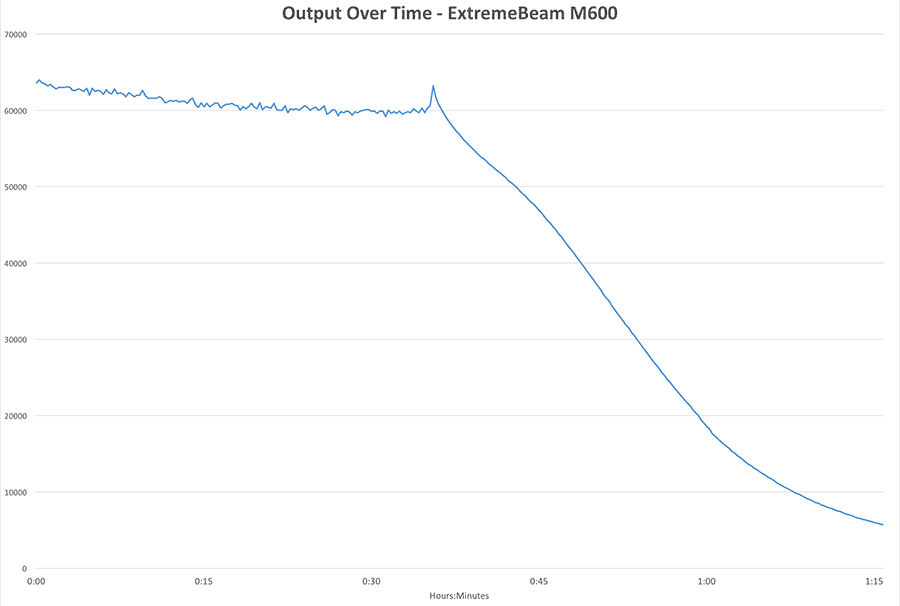
With a brand new set of CR123a batteries, I measured a runtime of only 74.5 minutes for the flashlight to go from its peak output (measured 30 seconds after being turned on) to 10% output.
A more reasonable measurement is from the peak output (at 30 seconds) to 50% output. For many people, this would be the point where the light drop is clearly noticeable and a change of batteries may be in order. This runtime was only 53 minutes.
To be clear, if ExtremeBeam is not measuring runtime as is done in the FL 1 standard, then any output (perhaps even less than 1% of peak) could count toward the company’s measured runtime. That is why these kinds of independent evaluations are so important.
For a more visual representation of light output over time, the below video shows the M600 running with a fresh set of Streamlight-branded CR123 batteries:
I should be careful to note that the brightness in the above video should not be compared to any of the similar light output videos I have done on other flashlights. Apparent brightness of the light can be altered by many things, and comparing brand A to brand B for brightness when neither was tested in a controlled environment would not be fair.
However, I believe the video is a fair representation of the unit’s light output relative to the initial output of the light. You can clearly see at what point the light levels drop.
It appears that the light output declined noticeably for about the first 80 minutes. This matches the output measured in the illuminating sphere.
After that, light output very slowly declined over the next five hours. From a completely subjective standpoint, at the end of the 6+ hour run test, the light still threw useable light, though it was not close to the original output.
Heat Output
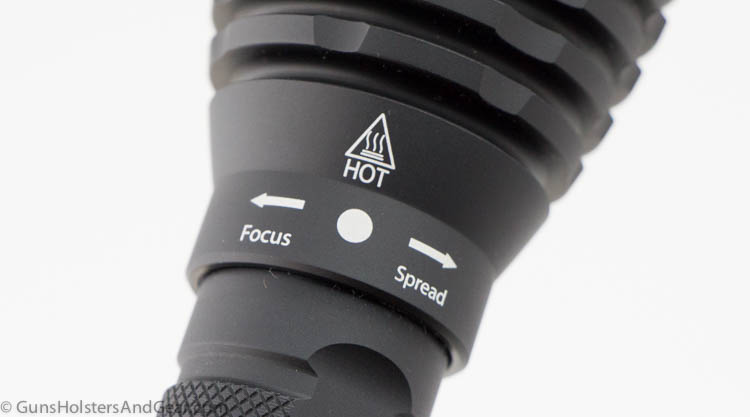
Generating a lot of light output can generate a lot of heat. LEDs are known to be much more efficient than incandescent bulbs, but they will still generate a lot of heat. The “HOT” warning on the head of the M600 is a clear indicator that this flashlight can generate heat on the high output setting.
This table shows the temperature measured on the surface of the flashlight:
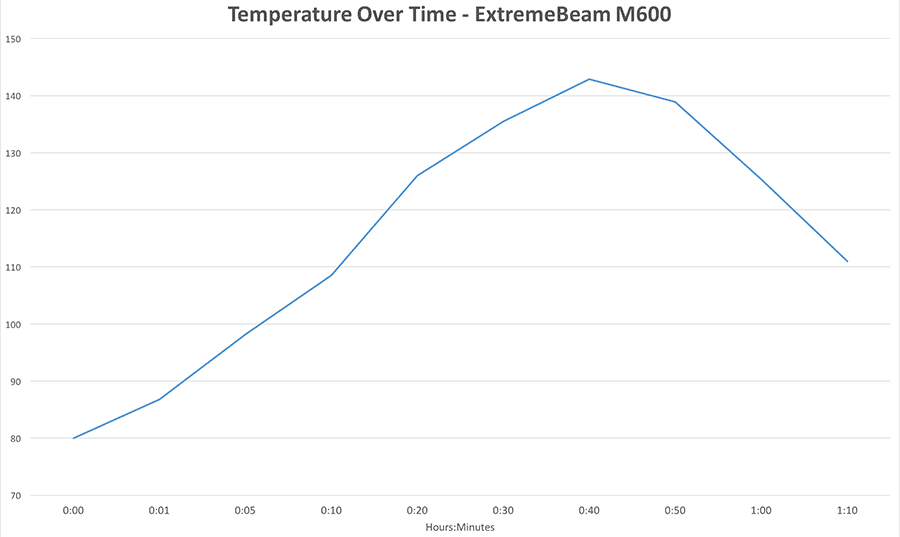
I measured a peak of 142.9° F at the 40-minute mark. After this, the heat began to decline rapidly. This coincides with the reduced light output. From the 20-minute mark through the 60-minute mark, the flashlight was too hot to hold for very long.
Visual Comparison
The measured output is all well and good, but you might be wondering how that looks. Take a look at the photos below. They were shot at night from a distance of 25′.


In the photo above, you should see a dividing line. Click or touch the line and drag it left or right. This will show you a control photo and the flashlight photo. Both photographs were shot at the same exposure, with the same camera mounted on a tripod and within seconds of each other.
For comparison purposes, take a look at the M600 (left side) and Streamlight ProTac HL (right). Both flashlights operate on a pair of CR123a batteries, though the Streamlight is a little more compact and rated at a higher output. However, ExtremeBeam lists a higher peak beam intensity (25,000 candelas vs. 18,300 candelas.) Both flashlights had fresh batteries, were taken seconds apart and shot from a tripod at the same exposure.


You can see that the light output is very similar between the two. It looks like the M600 was aimed slightly higher than the ProTac HL, but otherwise the beam and spill are pretty close at this distance. Measured runtime is also very similar.
Impact Resistance
ExtremeBeam states the M600 is drop resistant to 2.5 meters (roughly 8.2 feet.) A 2.5 meter drop rating is more than many of the flashlights I have tested, and with the company’s claims of being “virtually indestructible,” I had high expectations for the durability of this light. Unfortunately, I was disappointed.
Here is the video of the testing:
As you can see, the light failed after the fifth drop. I swapped the batteries and checked the connections, but the light would not turn on.
I contacted the company via e-mail and explained what had happened during this Extreme Beam flashlight review. I also shared with them the video of the drop test. The gentleman I exchanged e-mails with was courteous and helpful. After I checked a few things he suggested, I shipped the light back to them for repair. The turnaround time on getting the light back was about two weeks, which I found to be reasonable.
The original flashlight was returned to me with an explanation of the service done on the light. ExtremeBeam stated that the light had not suffered any broken parts. Instead, ExtremeBeam advised that a connection between a circuit board and the tail cap had come loose. Once reconnected, the light worked properly.
With the light functioning properly, I headed back out for another drop test: six more drops at the 2.5-meter height. This is the video of that test:
As you can see, the light failed again. This time the light made it ok for the first five drops, but on the sixth drop, it was dead. I checked all of the connections but it would not turn on.
I took the light to my workbench and swapped the batteries for fresh ones. This did not fix the problem.
I then removed the tail cap from the body of the light for a closer inspection. What I saw was unusual.
First, one of the batteries that had been in the light during the drop test was damaged. The bottom of the battery that sat against the flashlight pin to complete the power circuit was severely dented. The battery was not damaged when I inserted it into the flashlight prior to the second drop test. In testing more than 20 other flashlights, I have never seen the batteries damaged.
Second, there were marks on the face of the pin in the tail cap. Those marks were not present when I shipped the light back to ExtremeBeam for servicing, but I do not recall if they were there when the light was returned and before the second drop test.
Third, when I pressed on the pin with my finger, there was significant resistance. In fact, the pin appeared to be fixed in an extended position and would not depress.
When I forcibly pressed on the pin, I felt something snap inside the tail cap and the pin then depressed. At first, the pin movement was a touch gritty, but then smoothed out after several presses.
After this, I reassembled the light and found that the flashlight now worked.
What I suspect happened was that some form of glue or adhesive was used in the switch portion of the flashlight when it was fixed after the first failure. Either by accident or design, the adhesive wound up on the pin, preventing it from depressing under stress.
When the flashlight was dropped, the bottom battery was striking the pin. The pin was originally designed to depress under stress, which would have prevented damage to the battery. However, the pin, since it was prevented from depressing, simply damaged the battery.
Fortunately, the battery did not rupture.
Even though I was able to resolve the problem after the second drop test, I still consider the light failed the evaluation. It was only after I had time to open and examine the light that I discovered the problem. When the light was theoretically needed – after the drop – it stopped working. If I was relying on that light to illuminate a target, it would have failed me.
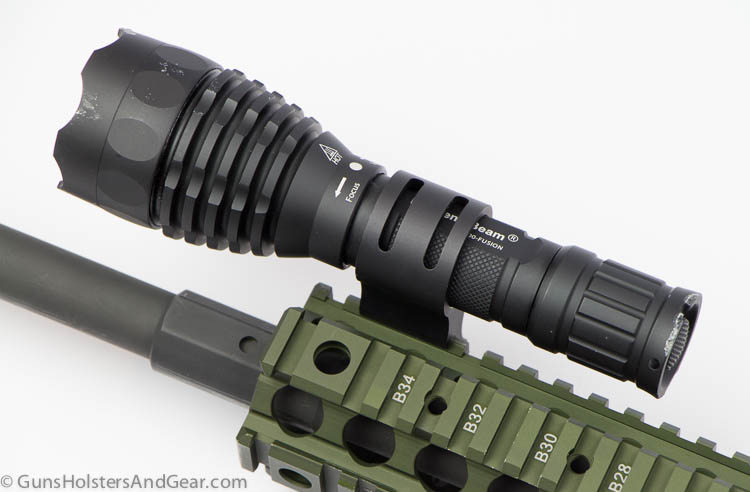
Additionally, through mistake or design, the servicing of the light after the first failure appears to have contributed to the failure in the second test. I find this to be completely unacceptable.
Readers may wish to take a look at my review of the ExtremeBeam M4. That flashlight uses the same style tailcap as the M600. The M4 also failed on the drop test in its review.
Water Resistance
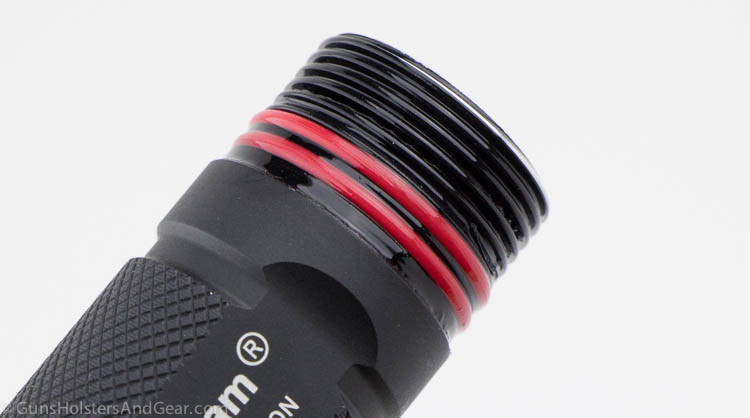
According to ExtremeBeam, the M600 is waterproof to 30 feet (approximately 9.1 meters.) This is much deeper than most tactical lights claim.
Unfortunately, I do not have a 30-foot deep swimming pool in which to test the flashlight. So, doing the best I could, I ran a test of the light at 5.5′. I recognize that this is merely a fraction of the stated rating, but it was the best I could do with the resources on hand.
In my testing, this evaluation is to be completed after the impact resistance test. Even though I marked the impact resistance test as a fail, I went ahead and did the water-resistance test. I figured the light would probably pass.
Here is the video of the water test:
As I expected, the M600 came through this test with flying colors. The double-O rings did the job and no water intruded into the body or head of the light. The light worked after the time in the pool with no obvious adverse effects.
I again note that this test was not at the level that ExtremeBeam claims the M600 can withstand. However, it does show that after the drop test, the light does remain waterproof to at least some measurable degree.
Final Thoughts
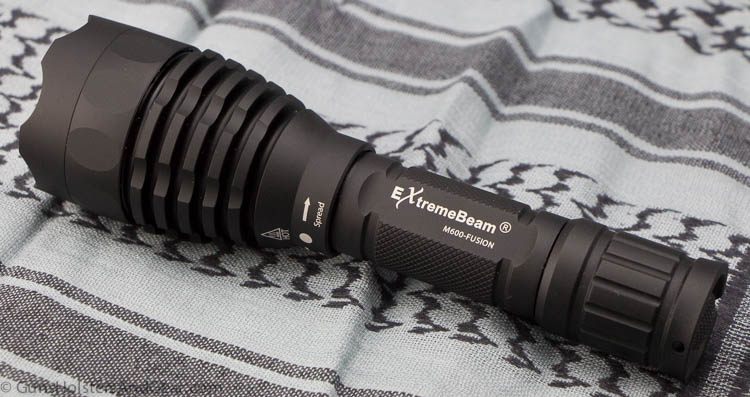
At the end of the day, I cannot recommend the ExtremeBeam M600 based on the evaluation I conducted.
While the problems should be obvious, I will highlight my concerns:
1. The flashlight failed to pass my drop test. After the first failure, ExtremeBeam was given an opportunity to fix the light and they did. The light then failed on the drop test a second time. This repeated failure precludes me from being able to recommend the light.
2. I do not like the controls of the light from a tactical standpoint. I want a light that will stay on high each time I momentarily flash it, not rotate to the next lower level. The ExtremeBeam control makes room clearing more like Forest Gump’s box of chocolates – you never know what you are going to get. This alone would not preclude me from recommending the light, but it is a significant problem if you are looking for a tactical flashlight.
3. The light output was acceptable for the first 53 minutes. However, it did not appear to meet the output over time levels I was told to expect by ExtremeBeam (full output for more than two hours.)
4. In my opinion, the adjustable floodlight did not add any useful functionality to the light. With the inconsistent problems that adjusting the beam width would cycle the light through the output levels, I’d rather see the company delete this feature.
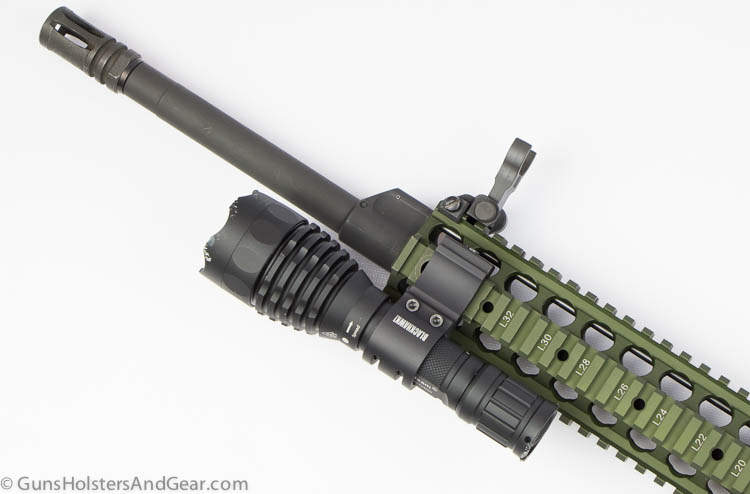
It is unfortunate that I cannot recommend this flashlight. If you own the M600, please share your experiences in the comments below.
I strongly suggest that you take a look at some of the other flashlights I’ve reviewed by clicking here.
Last Update: August 21, 2021
Disclosure
New readers of my site might not realize this, but I make an effort to be completely transparent about this Extreme Beam flashlight review. I value you, the reader, as my customer. It is you I serve with these reviews by trying to give you good information that you can use to make buying decisions. As such, I feel it is absolutely necessary for me to disclose any potential conflicts with that goal.
This flashlight was provided to me by ExtremeBeam for the purposes of review. The light was provided free of charge with no promises offered of a positive review. As should be obvious above, I point out problems when they happen.
I gave ExtremeBeam an opportunity to read this review prior to me publishing it for the purposes of (a) advising on any technical inaccuracies and (b) responding to the failure of the light. ExtremeBeam never responded to me, but the company’s media representative did acknowledge receipt of my correspondence. I make no assumptions as to what that might mean other than there are no inaccuracies in the article they wished to correct. If they respond, I will update this article as appropriate.
ExtremeBeam is not an advertiser, nor have I had any conversations with them to be one. No money or other things of value were offered in exchange for this review. If any of their ads appear here it would be through the Google AdSense network, of which I have very limited control.
GunsHolstersAndGear.com is a for-profit website. I do not charge readers a dime to access the information I provide.
Some of the links on this page and site are affiliate links to companies like Amazon and Palmetto State Armory. These links take you to the products mentioned in the article. Should you decide to purchase something from one of those companies, I make a small commission.
The links do not change your purchase price. I do not get to see what any individual purchases.
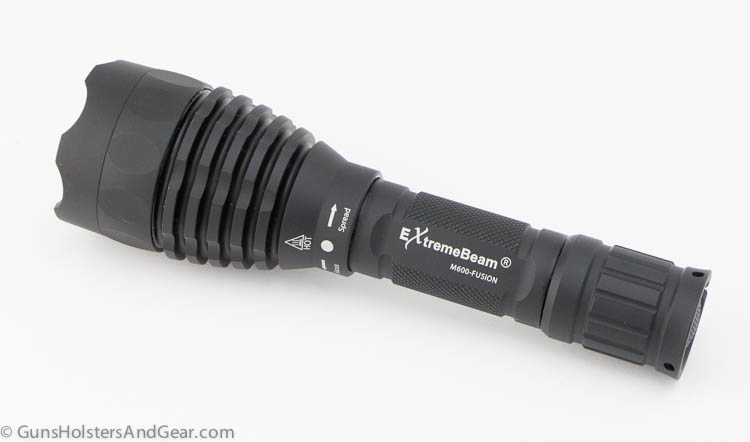
One reply on “ExtremeBeam M600 Flashlight Review”
My RC20 EDC tactical flashlight from fenix store is so far the best light I’ve bought online. The On and OFF button is separate from the output level button which makes it the best feature, then next is its brightness.